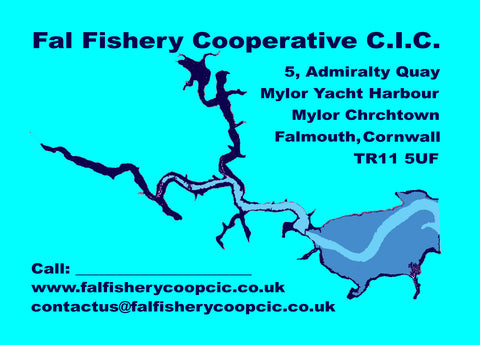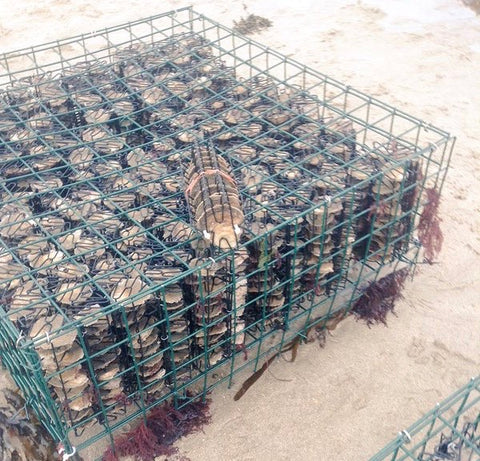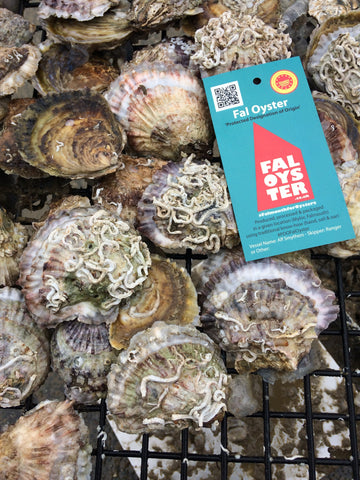Latest News
https://www.crowdfunder.co.uk/savingestertheoyster March 06 2020
#SavingESTER The Oyster February 01 2020
Saving 'Ester' - Cornish for 'Oyster'!
A Wild Cornish Native Oyster Hatchery - Crowdfunder Pitch
If you are just browsing or short of time right now, please just read the bold text OR look at the pictures showing growth stages AND sign up to our newsletter! EVEN THE SMALLEST DONATION WILL MAKE A REAL DIFFERENCE TO THE SURVIVAL OF THIS SPECIES, JUST £1 WILL SAVE ONE ESTER - A CORNISH NATIVE OYSTER!
Native Oyster Larvae Stages
Copyright: Rodriguez-Perez, A., Sanderson, W. G., Møller, L. F., Henry, T. B. & James, M. (2020). Return to sender: the influence of larval behaviour on the distribution and settlement of the European oyster Ostrea edulis.
(Manuscript submitted for publication.)
WE AIM TO HATCH AND RELEASE 1,000,000 CORNISH NATIVE OYSTERS IN TO THE FAL ESTUARY, CROWDFUNDING IS THE ONLY WAY WE CAN KICK START THIS PROJECT IN 2020
We will save large disease resilient Cornish Native Oysters and put them through a controlled hatchery program, so we can study the growth patterns of larvae & spat (baby oysters), then they will go through natural seawater settling and holding tanks, as well as upwellers and silos, TO ENCOURAGE AN INCREASE IN THE SURVIVAL RATE OF WILD NATIVE OYSTERS...
…"SEAFISH current survival rate for larvae to 12 months old in the wild is 1/500,000 or 0.0002%".
The project has very low expectations of just a 1% survival rate, however it is well understood in the USA that a 30%-60% survival rate can be achieved with hatchery born and nursery managed stocks. Also when mature oysters are stored at a density with many male & female oysters they will all help to trigger male oysters, when fertilized with billions of eggs created in the female shell they release millions of larvae in to their wild natural habitat, the Fal Estuary.
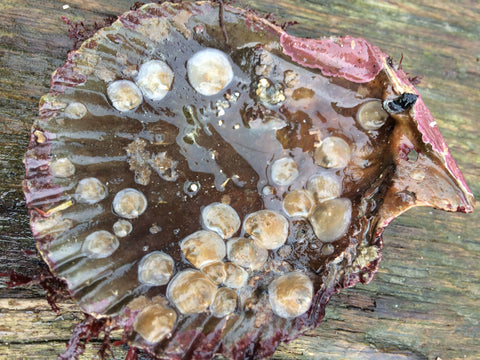
Oyster 'pediveliger spat' on a Queen Scallop Shell
The Fal Fishery Cooperative CIC is a ‘not for profit’ organisation, but like all other charities and community interest companies it has to cover overhead costs of administration, rent, research, staff and stock with or without grants/funding, it also has to build itself towards being a fair employer and sustainable habitat manager for the years, decades and centuries to come.
The director has recently co-authored two papers: European Native Oyster Restoration Policy (for peer review) and European Native Oyster Restoration Handbook (in prep)
Participating Contributor to:
Native Oyster Network UK & Ireland,
Native Oyster Restoration Alliance (NORA).
Research Centres:
Bangor University's Shellfish Research Centre.
Project Contractors:
National Lobster Hatchery Padstow,
Fal Oyster t/a Cornish Native Oysters,
Jersey Sea Farms.
If not us who, if not now when?
WHY IS THIS PROJECT SO IMPORTANT?
The Native Oyster Restoration Alliance (NORA) and the Berlin Oyster Recommendation: “bringing back a key ecosystem engineer by developing and supporting best practice in Europe” Bernadette Pogoda et al "Recommendations: Produce sufficient oysters for restoration of oyster reefs Background: Sufficient seed oyster supply is a key limiting factor for native oyster restoration projects in Europe. Translocation between sites of seed oysters or any other size classes from wild beds should be discouraged to avoid increasing the pressure on still existing wild beds and reduce the risk of spreading invasive species and disease. Recommendation: Action should be undertaken to support existing hatcheries, spatting ponds and spat collector techniques and to establish new hatcheries and spatting ponds for the production of robust and genetically diverse Ostrea edulis seed. Brood stock sanctuaries should be established and used for local reinforcements."
Native Oyster Tray Microreefs
Copyright Jersey Sea Farms Ltd
ENVIRONMENTAL SERVICES
Oysters play a vital role in filtering seawater and keeping marine habitats alive, just one oyster can filter over 200 litres almost 50 gallons every day, clean seawater also helps with photosynthesis, which in turn helps marine plant species!
It goes without saying that there is “No Planet B!” it has taken thousands and thousands of years for the Oyster to acclimatise and to be crowned as one of the longest serving edible seafoods. There is evidence primates have been using stone tools to eat shellfish for millennia, yet human overfishing, pollution and disease has wiped out 85-95% of the Native Oyster population in the past 2 decades alone. Overfishing juveniles before they have reproduced, unnecessary pollution into our estuaries and seas and eliminating the spread of diseased stock by screening, are all things we can change today by scientifically supported research and sustainable aquaculture.
Cornish Native Oyster Tray Growth, Depurated Fal Oysters
Copyright CJ Ranger
ECONOMIC VIABILITY
Historically, about 100 years ago, some 200 vessels landed 800 tonnes from the same 1100 hectares that is now managed under the Fal Fishery Regulatory Order 2016, unfortunately the relaying on the Fal Estuary of European Oyster seed in the 1950-60s wiped out indigenous English Native Oysters throughout the UK with a disease called Bonamia. A disease still found but one we hope to overcome. Stocks have recovered and maybe the offspring’s have become more resilient, but in the past few decades landings have peaked at about 100 tonnes between a few dozen or so vessels seen fishing on a daily basis. In 2019-20 season it is estimated that less than 20 tonnes will be harvested from less than a dozen vessels. Hundreds of families were probably yielding more revenue over a century ago than the majority of the fleet of sailing vessels that are barely earning a living today. By putting a million 1year old spat (baby native oysters) back in to the Fal Estuary every year we will be "putting more on than are taken off for relaying and consumption".

Lower Chart shows 'Actual Fishery Landings' blue columns 1-5 and 'Trending Estimated Landings' blue columns 6-7... so given the trends the 2020-21 season could be last for the sailing fleet and at what point will the biomass tipping point never recover?...
The long term problem with fishing out all the 2-3yr old juveniles, is they barely reach maturity (where the take one leave but more than one theory should exist) in their own natural habitat, so its an ever decreasing biomass. (“It’s been shown that systematic predation causes prey of smaller size” says Nathaniel Dominy of Dartmouth College in Hanover, New Hampshire)
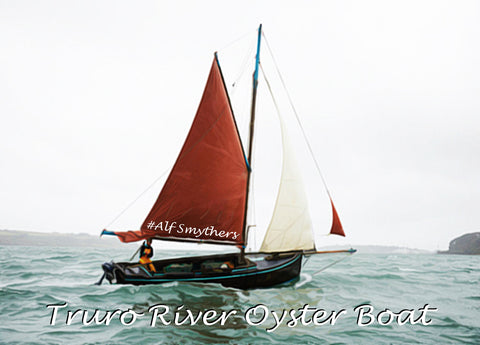
Truro River Oyster Boat 'Alf Smythers'
Artwork Copyright CJ Ranger
SOCIAL COMMUNITY
Heritage on the River Fal Fishery is believed to go back to the Phoenicians and Roman times and has been documented for more than 400 years – Sir Richard Carew wrote in 1602 of fishermen casting a “thick strong net fastened to three spills of iron and drawn to the boats stern, gathering whatsoever it meeteth lying in the bottom of the water, out of which when it taken up, they cull the oyster”. We need to provide for the future generations, not leave them with very few options to survive on...
The current problem is the 'effort or kg per dredge hour' shown by LPUE (yellow) in chart above is less than 1kg of native oysters per hand hauled dredge, per hour... 2 hand dredges, 6 hours = 12kg @ £3.80 = £45.60 per day as a solo skipper of a 8m sailing fishing vessel during the winter months... … So the numbers of vessels and crews drop off and the ground gets more and more silted up creating 'dead zones' with little or no marine life at all!
It now seems ever so destructive to tow for 20m and only get one native oyster!...
HOW CAN YOU HELP?
Even a donation of just £10 (and by sharing your pledge with everyone you know so they might donate too) will show us and many others how much you care about our environment (planet), economy (pounds) and social community (people), so we can all play a part and restore what was once a sustainable and efficient industry. Whether you enjoy eating oysters or whether you just want cleaner seas and a diverse marine ecosystem, by supporting this project you will help oysters that are a backbone species that improve habitat and encourage many other plant and animal species to flourish.
Even greater pledges/donations or corporate sponsorship and becoming a Patron* will help us build the project quicker, so we can hopefully influence regulators and policy makers to listen to the future scientific evidence, that will reverse the decline in stocks, provide not just a sustainable food resource, but more importantly a healthier habitat and living wage for the future generations of children and grandchildren that will ultimately inherit our only planet.

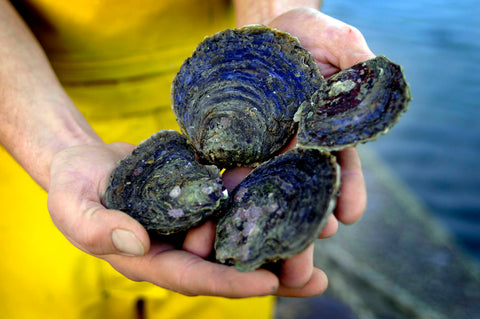
The CIC Director holding Cornish Native Oysters 2010
Copyright Mike Thomas
REWARDS FOR YOUR PLEDGES...
15-33% of your pledges will be spent on your rewards if you choose to collect them 67-85% of your pledges will be used to deliver the project if you choose to collect your rewards 100% of your donation will be used in the project if you prefer just to donate
The merchandise rewards (T Shirts, Hats, Aprons etc - see reward options) will be hand screen printed (by CIC) and locally embroidered so you can show off your support to others, you will be contacted for sizes before we order!
Genuine Fal Oysters that have been gathered by hand, sail and oar in the 2019-20 season OR for later rewards in 2020-21 season when they have been through the new crowd funded hatchery and nursery program.
*BRONZE, SILVER & GOLD PATRONS will be invited to play a part in the whole process, from fishery trips to grading & processing oysters, from taking part in the hatchery process to helping relocate the spat to the nursery area... WE WILL ALSO INVITE YOU TO ONE OF OUR OYSTER SHUCKING MASTERCLASSES AND OFFER DISCOUNTS ON PRIVATE FUNCTIONS SUCH AS OUR WEDDING OYSTERS BARS... If you wish to get further involved you may also be invited to become a subscriber, board member or director of the CIC.
At the final weekend of this 8 week pitch Steve Skinner will be hosting our fundraiser finale to celebrate the 10th birthday of Pop Up Gatherings at the Skinners Brewery Tap known as the Old Ale House in Truro with Sushi Master Goemon from Dinings Harcourt Street London (W1H 4HH) with bands on Friday & Saturday evening and Rosie Crow headlining Sunday afternoons British Summer Time Special (Thursday 26th to Sunday 29th March 2020).
STRETCH TARGETS...
We hope to reach the 1st Spring Target (above) within a matter of weeks as the target secures the first summers hatchery program. The 2nd Summer Target (below) is to secure the aquaculture site for a year ahead, the 3rd Autumn Target (below) is required to secure the moorings and infrastructure to store the hatchery stock once it has settled and grown to a size that can be placed in to the wild nursery, the 4th huge Winter Target is to purchase a grader, and year 2 rent, so scientific research data can be collected and used as evidence to encourage better fishery regulations, therefore prevent the overfishing of juveniles you have helped us to create.
WE CANNOT CONTINUE TO TAKE FROM THE ENVIRONMENT WITHOUT PUTTING SOMETHING BACK, AND WE CANNOT KICK START A HATCHERY PROGRAM WITHOUT SUPPORT AND FUNDING FROM YOU, THE CROWD! We may follow this pitch with other crowdfunding pitches if we don't reach our stretch targets. So please donate and spread the word to your own friends and families.
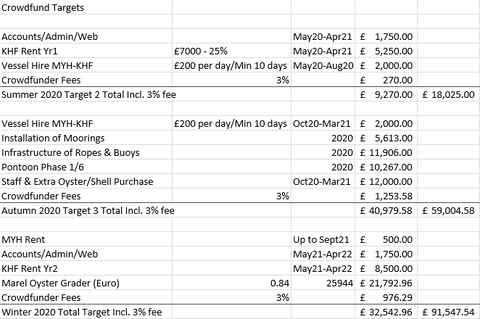
We then aim to fund scientific research in best practices in aquaculture, help responsibly manage hatchery & nursery stocks, support markets for a new generation of skippers & crew. Then, when the oysters have reproduced many times, a sustainable yield of 80-125g Cornish Native Oysters will be gathered and only when depurated by verified processors do they become prestigious PDO Fal Oysters with real provenance.
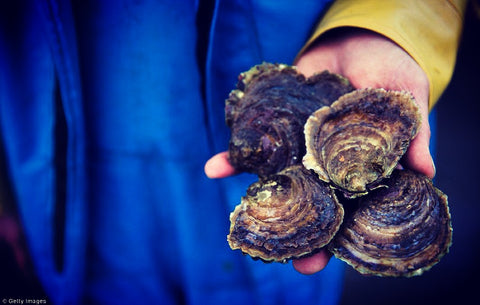
The Director holding Cornish Native 'Fal Oysters' 2016
Copyright Getty Images
SUPPORTING SCIENTIFIC EVIDENCE...
A 2yr old can produce 500,000 larvae and only 1 might survive 12 months, a 4yr old can produce 1,000,000 larvae and 2 might survive, but after 4 years 1+1+2=4 might be left after harvesting compared to maybe none left after harvesting a 2yr old!!
· 85-95% of the worlds population of European Native Oysters have been lost due to overfishing, disease and pollution - we aim to use what stock is left on the Fal Fishery to kick start a restoration program...
· The Principle Scientific Officer for the Fal Fishery Regulatory Authority stated "I fear we might be at a density of native oysters (1 per 20m2) that would make successful reproduction incredibly difficult" - we aim to store hatchery produced stock and legal juveniles too small to eat in a biomass greater than 5m2...
· There is only one UK hatchery, yet there are already 7 restoration projects in the UK alone that are struggling to source disease free native oyster seed - with a 1% fertilization and 67% survival each year we aim to create A MILLION 40-80g juveniles in year 2-3 from our local hatchery...
· IF YOU ARE INTERESTED IN THE SCIENCE THERE IS A LOT MORE DETAIL ABOUT OUR PROJECT AND TO STAY INFORMED...
Sign up to our Mailchimp Newsletter by clicking here
Follow us and find out more: www.falfisherycoopcic.co.uk
A HUGE THANK YOU FOR TAKING THE TIME TO READ THIS AND HOPE IT MAKES SENSE #SavingESTER !
Saving 'Ester' - A Cornish Native Oyster!
A Wild Cornish Native Oyster Hatchery
If you are just browsing or short of time right now, please just read the bold text and sign up to our newsletter!
WE AIM TO HATCH AND RELEASE 1,000,000 CORNISH NATIVE OYSTERS IN TO THE FAL ESTUARY, CROWDFUNDING IS THE ONLY WAY WE CAN KICK START THIS PROJECT IN 2020
EVEN THE SMALLEST DONATION WILL MAKE A REAL DIFFERENCE TO THE SURVIVAL OF THIS SPECIES, JUST A POUND WILL SAVE AN ESTER - A CORNISH NATIVE OYSTER!
We will save larger disease resilient Cornish Native Oysters and put them through a controlled hatchery program so we can study the growth patterns of larvae & spat (baby oysters) through settling and holding tanks, as well as floating upwellers and eventually natural seawater silos TO ENCOURAGE AN INCREASE IN THE SURVIVAL RATE OF WILD NATIVE OYSTERS...
…"SEAFISH current survival rate for larvae to 12 months old in the wild is 1/500,000 or 0.0002%".
The project has very low expectations of just a 1% survival rate, however it is well understood in the USA that a 30%-60% survival rate can be achieved with hatchery born and nursery managed stocks. Also when stored at a density with many male & female oysters they will all help to trigger male oysters, when fertilized with billions of eggs created in the females this releases millions of larvae in to their wild natural habitat, the Fal Estuary.
Oyster 'spat' on a Queen Scallop Shell showing the importance of 'cultch' - Copyright CJ Ranger
Sign up to our Mailchimp Newsletter by clicking here
Follow us and find out more: www.falfisherycoopcic.co.uk
The Fal Fishery Cooperative CIC is a ‘not for profit’ organisation, but like all other charities and community interest companies it has to cover overhead costs of administration, rent, research, staff and stock with or without grants/funding, it also has to build itself towards being a fair employer and sustainable habitat manager for the years, decades and centuries to come.
The director has recently co-authored two papers: European Native Oyster Restoration Policy (for peer review) and European Native Oyster Restoration Handbook (in prep)
Project partners include: Native Oyster Network UK & Ireland, Native Oyster Restoration Alliance (NORA), Bangor University's Shellfish Research Centre, Marine I at University of Exeter Penryn Campus, Fal Oyster t/a Cornish Native Oysters, Jersey Sea Farms and the National Lobster Hatchery Padstow.
If not us who, if not now when?
WHY IS THIS PROJECT SO IMPORTANT?
The Native Oyster Restoration Alliance (NORA) and the Berlin Oyster Recommendation: “bringing back a key ecosystem engineer by developing and supporting best practice in Europe” Bernadette Pogoda et al "Recommendations: Produce sufficient oysters for restoration of oyster reefs Background: Sufficient seed oyster supply is a key limiting factor for native oyster restoration projects in Europe. Translocation between sites of seed oysters or any other size classes from wild beds should be discouraged to avoid increasing the pressure on still existing wild beds and reduce the risk of spreading invasive species and disease. Recommendation: Action should be undertaken to support existing hatcheries, spatting ponds and spat collector techniques and to establish new hatcheries and spatting ponds for the production of robust and genetically diverse Ostrea edulis seed. Brood stock sanctuaries should be established and used for local reinforcements."
Native Oyster Tray Microreefs - Copyright Jersey Sea Farms Ltd
ENVIRONMENTAL SERVICES
Oysters play a vital role in filtering seawater and keeping marine habitats alive, just one oyster can filter over 200 litres almost 50 gallons every day, clean seawater also helps with photosynthesis, which in turn helps marine plant species!
It goes without saying that there is “No Planet B!” it has taken thousands and thousands of years for the Oyster to acclimatise and to be crowned as one of the longest serving edible seafoods. There is evidence primates have been using stone tools to eat shellfish for millennia, yet human overfishing, pollution and disease has wiped out 85-95% of the Native Oyster population in the past 2 decades alone. Overfishing juveniles before they have reproduced, unnecessary pollution into our estuaries and seas and eliminating the spread of diseased stock by screening, are all things we can change today by scientifically supported research and sustainable aquaculture.
Cornish Native Oyster Tray Growth, Depurated Fal Oysters - Copyright CJ Ranger
ECONOMIC VIABILITY
Historically, about 100 years ago, some 200 vessels landed 800 tonnes from the same 1100 hectares that is now managed under the Fal Fishery Regulatory Order 2016, unfortunately the importation of European Oyster seed in the 1950-60s wiped out indigenous English Native Oysters throughout the UK with a disease called Bonamia. Stocks have recovered and maybe the offspring’s have become more resilient, but in the past few decades landings have peaked at about 100 tonnes between a few dozen or so vessels seen fishing on a daily basis. In 2019-20 season it is estimated that less than 20 tonnes will be harvested from less than a dozen vessels. Hundreds of families were probably yielding more revenue over a century ago than the majority of the fleet of sailing vessels that are barely earning a living today. By putting a million 1year old spat (baby native oysters) back in to the Fal Estuary every year we will be "putting more on than are taken off for relaying and consumption".
Chart shows 'Actual Fishery Landings' blue columns 1-5 and 'Trending Estimated Landings' blue columns 6-7... so given the trends the 2020-21 season could be last for the sailing fleet and at what point will the biomass tipping point never recover?... The long term problem with fishing out all the 2-3yr old juveniles, is they barely reach maturity (where the take one leave but more than one theory should exist) in their own natural habitat, so its an ever decreasing biomass. (“It’s been shown that systematic predation causes prey of smaller size” says Nathaniel Dominy of Dartmouth College in Hanover, New Hampshire)
Truro River Oyster Boat 'Alf Smythers' - Artwork Copyright CJ Ranger
SOCIAL COMMUNITY
Heritage on the River Fal Fishery is believed to go back to the Phoenicians and Roman times and has been documented for more than 400 years – Sir Richard Carew wrote in 1602 of fishermen casting a “thick strong net fastened to three spills of iron and drawn to the boats stern, gathering whatsoever it meeteth lying in the bottom of the water, out of which when it taken up, they cull the oyster”. We need to provide for the future generations, not leave them with very few options to survive on...
The current problem is the 'effort' shown by LPUE in chart above is less than 1kg of native oysters per hand hauled dredge, per hour... 2 hand dredges, 6 hours = 12kg @ £3.80 = £45.60 per day as a solo skipper of a 8m sailing fishing vessel during the winter months... So the numbers of vessels and crews drop off and the ground gets more and more silted up creating 'dead zones' with little or no marine life at all!
HOW CAN YOU HELP?
Even a donation of just £10 (and by sharing your pledge with everyone you know so they might donate too) will show us and many others how much you care about our environment (planet), economy (pounds) and social community (people), so we can all play a part and restore what was once a sustainable and efficient industry. Whether you enjoy eating oysters or whether you just want cleaner seas and a diverse marine ecosystem, by supporting this project you will help oysters that are a backbone species that improve habitat and encourage many other plant and animal species to flourish.
Even greater pledges/donations or corporate sponsorship and becoming a Patron* will help us build the project quicker, so we can hopefully influence regulators and policy makers to listen to the future scientific evidence, that will reverse the decline in stocks, provide not just a sustainable food resource, but more importantly a healthier habitat and living wage for the future generations of children and grandchildren that will ultimately inherit our only planet.
The Director holding Cornish Native Oysters 2010 - Copyright Mike Thomas
REWARDS FOR YOUR PLEDGES...
15-33% of your pledges will be spent on your rewards if you choose to collect them 67-85% of your pledges will be used to deliver the project if you choose to collect your rewards 100% of your donation will be used in the project if you prefer just to donate
The merchandise rewards (T Shirts, Hats, Aprons etc - see reward options) will be hand screen printed (by CIC) and locally embroidered so you can show off your support to others
Genuine Fal Oysters that have been gathered by hand, sail and oar in the 2019-20 season OR for later rewards in 2020-21 season when they have been through the new crowd funded hatchery and nursery program.
*BRONZE, SILVER & GOLD PATRONS will be invited to play a part in the whole process, from fishery trips to grading & processing oysters, from taking part in the hatchery process to helping relocate the spat to the nursery area... If you wish to get further involved you could also be invited to become a subscriber, board member or director of the CIC.
At the final weekend of this 8 week pitch Steve Skinner will be hosting our fundraiser finale to celebrate the 10th birthday of Pop Up Gatherings at the Skinners Brewery Tap known as the Old Ale House in Truro with Sushi Master Goemon from Dinings Harcourt Street London (W1H 4HH) with bands on Friday & Saturday evening and Rosie Crow headlining Sunday afternoons British Summer Time Special (Thursday 26th to Sunday 29th March 2020).
STRETCH TARGETS...
We hope to reach the 1st Spring Target (above) within a matter of weeks as the target secures the first summers hatchery program. The 2nd Summer Target (below) is to secure the aquaculture site for a year ahead, the 3rd Autumn Target (below) is required to secure the moorings and infrastructure to store the hatchery stock once it has settled and grown to a size that can be placed in to the wild nursery, the 4th huge Winter Target is to purchase a grader, and year 2 rent, so scientific research data can be collected and used as evidence to encourage better fishery regulations and therefore prevent the overfishing of juveniles you have helped us to create.
WE CANNOT CONTINUE TO TAKE FROM THE ENVIRONMENT WITHOUT PUTTING SOMETHING BACK, AND WE CANNOT KICK START A HATCHERY PROGRAM WITHOUT SUPPORT AND FUNDING FROM YOU, THE CROWD!
We may follow this pitch with other crowdfunding pitches if we don't reach our stretch targets. So please donate and spread the word to your own friends and families.
We then aim to fund scientific research in best practices in aquaculture, help responsibly manage hatchery & nursery stocks, support markets for a new generation of skippers & crew. Then, when they have reproduced many times, a sustainable yield of 80-125g Cornish Native Oysters will be gathered and only when depurated by verified processors do they become PDO Fal Oysters. Only then can they be enjoyed as truly sustainable ‘Fruits of the Sea’ with a prestigious Protected Designation of Origin provenance, for centuries to come!
The Director holding Cornish Native 'Fal Oysters' 2016 - Copyright Getty Images
SUPPORTING SCIENTIFIC EVIDENCE...
A 2yr old can produce 500,000 larvae and only 1 might survive 12 months, a 4yr old can produce 1,000,000 larvae and 2 might survive, but after 4 years 1+1+2=4 might be left after harvesting compared to maybe none left after harvesting a 2yr old!!
· 85-95% of the worlds population of European Native Oysters have been lost due to overfishing, disease and pollution - we aim to use what stock is left on the Fal Fishery to kick start a restoration program...
· The Principle Scientific Officer for the Fal Fishery Regulatory Authority stated "I fear we might be at a density of native oysters (1 per 20m2) that would make successful reproduction incredibly difficult" - we aim to store hatchery produced stock and legal juveniles too small to eat in a biomass greater than 5m2...
· There is only one UK hatchery, yet there are already 7 restoration projects in the UK alone that are struggling to source disease free native oyster seed - with a 1% fertilization and 67% survival each year we aim to create A MILLION 40-80g juveniles in year 2-3 from our local hatchery...
· IF YOU ARE INTERESTED IN THE SCIENCE THERE IS A LOT MORE DETAIL ABOUT OUR PROJECT AND TO STAY INFORMED...
Sign up to our Mailchimp Newsletter by clicking here
Follow us and find out more: www.falfisherycoopcic.co.uk
A HUGE THANK YOU !
Cornish Oyster Opening Championship 2018 October 07 2018
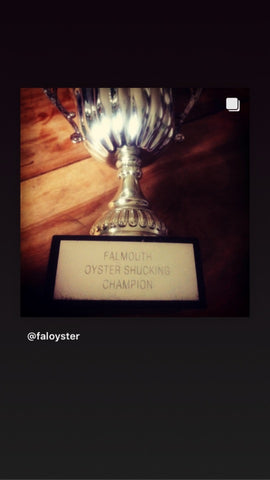
As current #falmouthoysterfestival #oystershuckingchampionship #oystershuckingchampion and therefore #cornishoysteropeningchampion 😁 I asked @faloysterfest if they would adopt the rules for the @tabasco #tabascooysters #oysteropeningcompetition of 30 #nativeoysters? so the winner could earn a place at the #ukcompetition to hopefully ultimately compete in the @galwayoysterfest #worldoysteropeningchampionships... 🤔 “no” 👎 because this years event maybe just 6 oysters for each competitor to open on stage 🙈 I’d like to declare the inaugural #CornishNativeOysterOpeningChampionships #CornishOysterShuckingChampionships will be held @thefrontfal #Falmouth on Saturday 13th October 2018 at 7pm 🤩 - to enter your nominee (must be a business that nominates one named entry) and receive a copy of the @tabasco_uk rules please email shucker@faloyster.co.uk - the winner will receive a return sleeper train 🚆ticket to London for the 2019 Tabasco Championships (sponsored by @FalOyster) and maybe earn a place at the #worldchampionships in Ireland 2019 🙏
Falmouth Oyster Shucking Competition Champion 2017 September 23 2018

After many years competing 2017 was my year! 2 minutes to open and present just 8 native oysters was enough to join the list of names on the trophy!
Then from that I went on to compete in the Tabasco UK Oyster Opening Championships... a disappointing 15th out of 20 with almost 6 minutes to open and present 30 natives, but hats off the Federico with 2 minutes 47 seconds, for 30 !
Celebrating 10 years... September 01 2018
I am celebrating 10 years! And over 400 years for the fishery!Cornish Queenie Scallops January 24 2018
Sustainability Overview
The queen scallops that grow on the Falmouth oyster beds are a delicacy that are caught as a by catch of the Fal oyster fishery. A traditional fishery that is restricted to sail and oar power and thus is extremely sustainable. Falmouth Queen scallops have been appreciated by local oystermen for generations but have rarely been sold commercially.
Biology
Queen scallops found in the Fal estuary are beleived to be a mixture of 2 species Chlamys varia and Aqupecten opercularis which that they live attached to the seabed by byssus threads similar to those used by mussels to cling on to rocks. They are fast growing and highly abundant animals that are found growing on empty oyster shells on the Fal and Helford oyster beds.
Management
The fishery is managed by a local restrictive order that banned the use of engines or winches in the fal oyster fishery in 1868. This has preserved a traditional fishery which is naturally inefficient and thus has sustained this traditional livelihood for 150 years.
http://www.cornwallgoodseafoodguide.org.uk/fish-guide/queen-scallop.php
Fal Oyster Hole & Corner Magazine April 22 2017
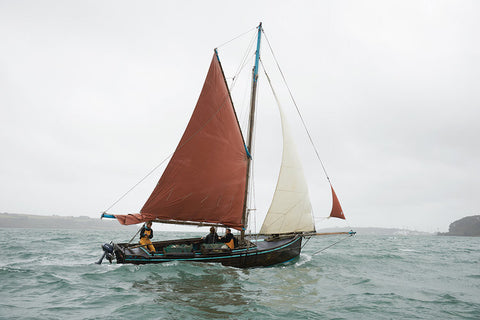
Massive thanks to Hole & Corner Magazine issue 4 for the article and photos... read more here http://www.holeandcornermagazine.com/fal-oysters
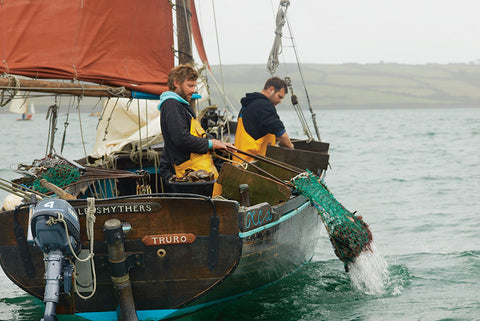
New premises at Cornish Native Oysters November 15 2016
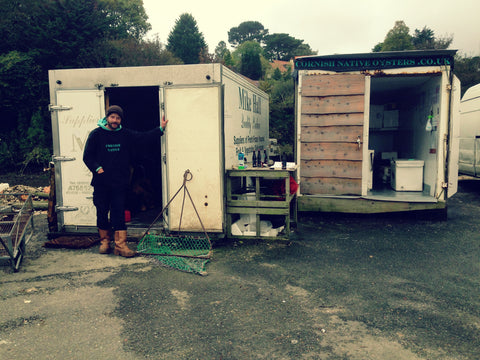
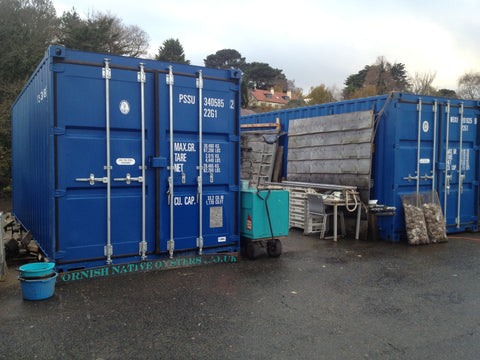

BBC Food & Farming Awards - Fal Oyster Ltd. - Best Food Producer January 19 2016
Here is the reply after sending a box of Fal Oysters...
"Thank you very much for sending through the samples for the BBC Food & Farming Awards judging meeting last week. The judges were impressed with your products, but I’m afraid that they did not select Fal Oyster to go through to the finalist stage. Real congratulations though – out of over 1000 nominations, to get through to the last 20 is brilliant. "
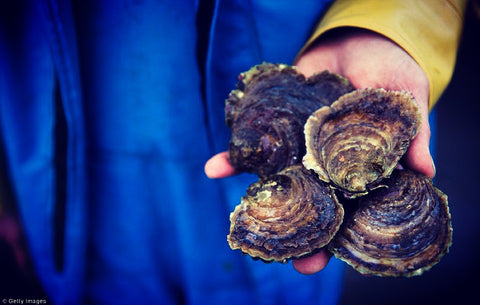
Here is my own 2016 nomination...
If I had a member of staff, I would have asked them to submit a nomination, but it's just me at the mo, so I though what the hell...
I've entered Best Food Producer category, because I believe we are one of them! But you can always nominate me and the pop up team for Street Food trader category ;)
Q1
Describe the food being produced. What do they make? Include the range of products, taste, price and where and how it’s sold. (250-300 words) 281
Unique gatherer and merchant of wild Cornish Native ‘Fal Oysters’, Fal Oyster Ltd. is the first company to conform to Trading Standards verification and have authority to use ‘Protected Designation of Origin’ on any oyster! Not to be mistaken for farmed Pacific oysters, these wild natives have a very distinct shape and flavour of melon and cucumber (fresh and zincy).
I supply top restaurants all over London and in the South West – I have appeared in numerous national papers; Guardian/Times/Telegraph and even on BBC Country File with Matt Baker a few years ago (although he said he liked oysters when we met, he later told Fiona Ware he preferred the ‘cooked’ ones ;) on national TV!)
Produced aboard a traditional sailing fishing vessel, one of the last wooden Falmouth Working Boats that I rebuilt in 2008 – AlfSmythers.co.uk
Processed in premises approved by DEFRA, CEFAS & Cornwall Council and many others trade price from 65p – CornishNativeOysters.co.uk
Packaged at the fishery for retail and wholesale distribution to homes and top restaurants, also showcased at my own pop up restaurant & bar, retail price from £1.65 – Ostraca.co.uk
Whilst the native oyster season is only September to April, the business has diversified during the summer months with the pop up events and festivals showcasing and working with other local artisan producers – PopUpGatherings.co.uk.
Since the launch of our unique pop up Ostraca we have worked closely with other top producers and served the freshest shellfish caught or harvested within 25 miles - such as Tempura Porthilly Rock Oysters 3 for £10 or Whole Cooked Crab at Carlyon Beach for £15
All can be viewed under the main company Fal Oyster Ltd. by visiting our website – faloyster.co.uk
Q2
Why should this producer win an award? What makes them and their food so special? (200-300 words) 244
I would really like to win this, not for me but for the Fal Oyster! The ONLY oyster with a PDO !
Since buying an old wooden boat in 2008 I have learnt to restore wooden vessels, learnt to sail properly, and learnt a 500 year old industry gathering wild Fal Oysters under sail and oar, using just the wind and the tides.
Once ashore they have to be carefully weighed and graded, some are stored in unique storage trays I designed to reduce the mortality. A small part of the process has saved hours in processing when it comes to purifying and documenting movements of Live Shellfish.
The sale of high risk foods comes at a price, but I have fully approved premises and a recognised food producer UKCQ710EC. Everything I have built over the years has been on a shoe string, financed by friends and family, and not paying myself, but with a little recognition I’m sure I can turn things round and make a living from this incredible industry.
I have all the credentials to go with a very unique food product, Fal Oysters, which admitted may not be everyone’s first choice, but I have tempted many to try and have a very high success rate, I believe Fal Oysters are very good for us and the environment.
The Fal Oyster has only just achieved this status, so I hope we are at the beginning of some positive recognition for the fishery.
CrowdFund pitch is now live! January 17 2016
#Crinnis - Press Release 2 - Mark Apsey June 08 2015
'Shellfish BRUT' - Fal Oyster and Camel Valley BRUT September 15 2014

Exciting news... during the summer we met up with Sam at Camel Valley Wines and asked if we could sell Camel Valley Sparkling Wines with our unique Fal Oysters in our new pop up restaurant & bar - Ostraca.co.uk - his reply was better than we had ever hoped for as they didn't have anyone they could work with at outdoor events, festivals, weddings etc.
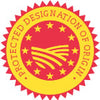
Ostraca Cornish Shellfish Box is the "1st Official Camel Valley Wine Bar" - and with the new Protected Designation of Origin status for our 'Fal Oyster' - we think we have a winner on any menu with "Cornwall's reply to the French Champagne & Oyster" !
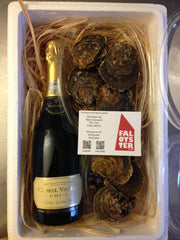
Can't wait... well then you can order online now...
Stunning Pop Up Venue - Ostraca April 21 2014
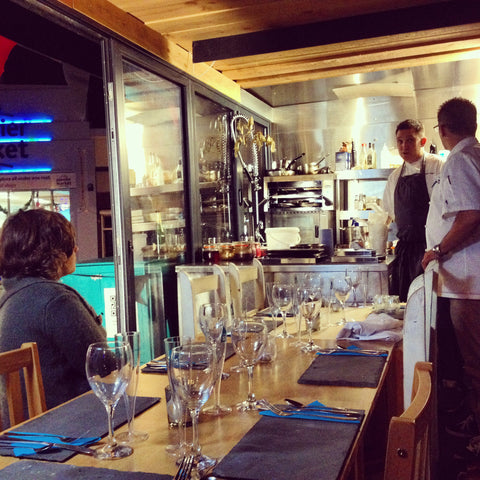
The unique Pop Up Restaurant is now available for hire - weddings, parties, private dining and social gatherings - visit ostraca.co.uk for latest information and contact details

Shellfish Association of Great Britain November 27 2013

Fal Oyster Ltd. is a member of the Shellfish Association of GB
'Shadow' 1870 November 27 2013

We are pleased toannounce that Ranger has purchased the oldest vessel of the fleet. 'Shadow' was built by Frank Hitchens of Point Feock in around 1870... She needs a little work, but she will rejoin the Fal Oyster fleet sooner than 'Boy Phil'. If you are interested in sponsoring or funding some of the restorations, please email ranger@alfsmythers.co.uk
Protected Name Status - Fal Oyster November 16 2013
Finally, news of our unique wild native Fal Oyster get the recognition it deserves... Protected Designation of Origin (PDO) - covers agricultural products and foodstuffs which are produced, processed and prepared in a given geographical area using recognised know-how
http://ec.europa.eu/unitedkingdom/press/frontpage/2013/13_127_en.htm
Free delivery... September 12 2013
Free delivery on orders over £50 in September 2013...Natives are back in season September 10 2013
With an 'R' in the month natives are back in season in the UK and this was celebrated at the 21st Tabasco British Oyster Opening Competition at J Sheekey's Oyster Bar on 09/09/13 - congratulations Sam from Wiltons... we have some lay stock from the beach available prior to our season starting on the 1st October... Pre order now for the first wild Fal OystersAvailable now... Porthilly Rock Oysters and Wild Fal Mussels... May 20 2013
Due to popular demand from local chefs, we are pleased to announce we can now supply Porthilly Rock Oysters, Wild Fal Mussels and Camel Valley Wines... check out the store for more details...
Falmouth's Original Oyster Bar reopens for Falmouth Food & Drink Week 9-17 Feb February 07 2013
Taken from: http://www.heritagepubs.org.uk/pubs/national-inventory-entry.asp?pubid=12
Thank you for all the orders over the Festive Period... January 04 2013
We really thought that with Christmas and New Year falling on a Tuesday the delivery schedule would be a real problem, but we planned well in advance and with the exception of two late deliveries we successfully delivered thousands of oysters to homes and restaurants across the UK and even as far as Kuala Lumper! Thanks to Carn Logistics, Rossmore Oysters and Azah for the big dispatch days... We totally sold out and in fact could have done with another 18 oysters! A Happy and Prosperous 2013 to you all... Thank you!Guardian News - Shell out for this season's oysters... November 29 2012

Britain's native oysters are in decline, depriving fishermen of a living and food lovers of a wonderful treat. And the best way to save them? Eat more of them...
BBC News - 'Eat UK oysters' October 23 2012
http://www.bbc.co.uk/news/science-environment-20042050
Time to polish the trophy, Silver Oyster Race, November 5th... October 23 2012
The annual Silver Oyster Race was held, at Mylor Yacht Club, in a bracing force-five wind from the north, but this did not deter 13 working boats from commemorating the Truro Oyster fishery’s High Court victory over Truro Corporation on November 5, 1901. This allowed the oyster fishermen to leave their dredged oysters in bags along the foreshore free of charge, before the catch is sent to market. Since then, November 5 has been a holiday for the oystermen and the custom is for licensed and unlicensed working boats to race, hosted by Mylor Yacht Club, for two silver trophies cast from oyster shells. In the large unlicensed class of boats, two experienced racing crews in Lola and Moon had a close battle all round the course, but ultimately Lola (Sandy Creeder) won by just over a minute. Deliverance (Mike Stratton) sailed an extremely good race to win the small unlicenced class. In the licensed boats, sailed with their everyday working sails, Alf Smythers (Chris Ranger) pulled out a five-minute lead over Ada (Jason Pascoe) to win this year's Silver Oyster. The prizes were awarded in the bar at Mylor YC by the Commodore, Alan Ramsden. The race course took the boats through water near St Mawes Bank which, if the recommendations in the Finding Sanctuary report are adopted, may be out of bounds to them in future; this despite the fact that the oystermen themselves have for many decades maintained and, uniquely, worked under sail a successful, sustainable oyster fishery. http://www.falmouthpacket.co.uk/sport/sailing/9351263.Lola_takes_victory_in_Mylor_Yacht_Club_s_Silver_Oyster_Race/r/?ref=rss- Page 1 of 2
- Next


